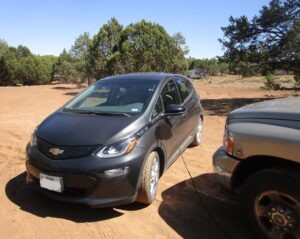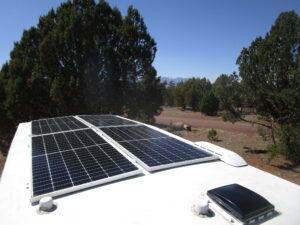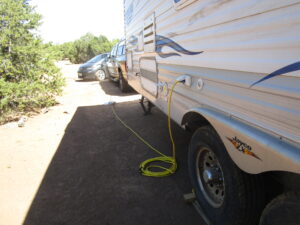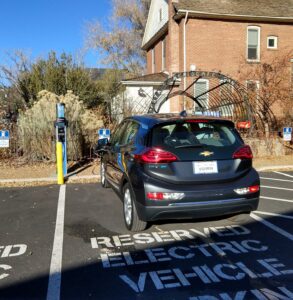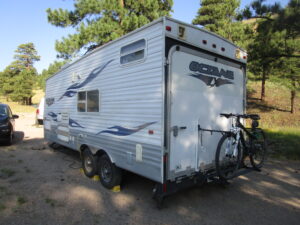Here’s a fun topic I have wanted to write about for a while. It’s not highly significant, simply something new and different in our world.
We bought an electric car, a 2017 Chevrolet Bolt EV (named Bev):
We have solar on the roof of our travel trailer and a big battery bank inside. When we’re boondocking (living off-grid) with excess incoming solar energy, we can plug the car into our “house” and add several kWh’s to it.
Free renewable energy for driving – almost directly from the sun. Complete self-sufficiency! As long as we don’t need to drive very far, of course.
Mostly it’s the novelty of it. A car plugged into a travel trailer isn’t something you see very often. Here is Bev with a cord running next to Tug the truck (and over to Howie the trailer):
We can do this in the summer, when the daylight hours are longer and the panels bring in way more energy than we can use, assuming the roof has a clear view of the sky and the sun is shining. The main power draw inside our house (when it isn’t winter) is the heat pump air conditioner, and it’s super efficient in cooling down the small space.
Solar panels in the summertime sunshine:
Usually we use a manual timer to alert us when to unplug the car so we don’t over-draw the battery bank, especially in the evening after the sun is gone. We’re testing an auto-shutoff timer in line with the extension cord, but I’m not (yet) totally confident in it. We will keep looking for a better solution, maybe in the car’s programming or perhaps something integrated in the trailer circuitry.
A typical daily EV charge would be 3 to 4 kWh when conditions are good. The main reason we can even charge that much is because John has upgraded the battery bank to one with 10.5 kWh capacity.
This is purely supplemental charging. We primarily use public EV chargers or an RV park utility post (when we’re not boondocking) to fuel the car. As an aside, recently we purchased a Level 2 (7 kW) charger to plug into the 50-amp outlet at the RV park, which allows us to completely recharge the car overnight. That’s about as easy as it gets.
Public charging station – this one is even free:
The Progress/Status page of this website has a chart for “EV charging sources” where I track the amount of Howie solar and other sources of power used for charging the car each month.
In the summer of 2021 during various boondocking stints, we moved a total of 134 kWh from the sun, through the solar panels and batteries in Howie, then to Bev.
This equates to a total of approximately 469 miles (at roughly 3.5 miles per kWh). It’s not a lot at a time, perhaps 10-12 miles per day. Still, it’s not nothing either, and it’s energy that would otherwise be wasted.
Compared to our ICE (internal combustion engine) truck at 20 mpg, and that’s 23.5 fewer gallons of gas we might have purchased. Diesel costs around $4 per gallon these days, equating to a savings of $94.
Hey, that’s actually pretty good. We started this all-electric project with the goal of making changes in the name of living a cleaner (and still mobile) lifestyle and without much focus on the money side. But if we can save a few bucks here and there, that will lend slightly more credence to the concept.
In addition, when we finally (maybe in 2022??) have our electric truck, solar charging is useful as an emergency backup in case we ever need just a few more miles to make it to the next EV charger.
Just a little side project that might come in handy someday!

